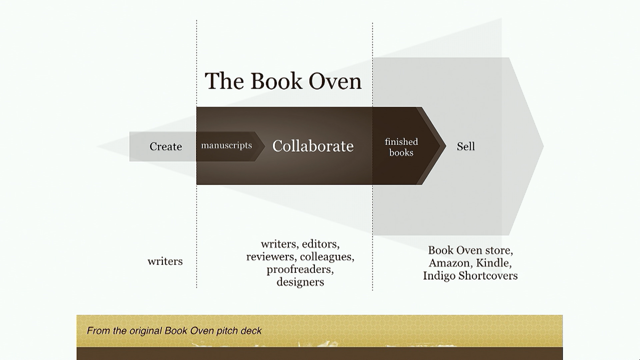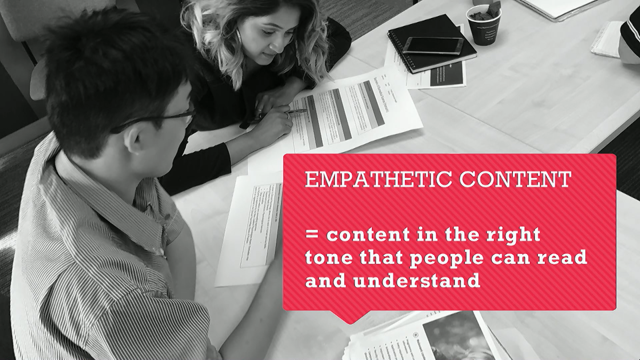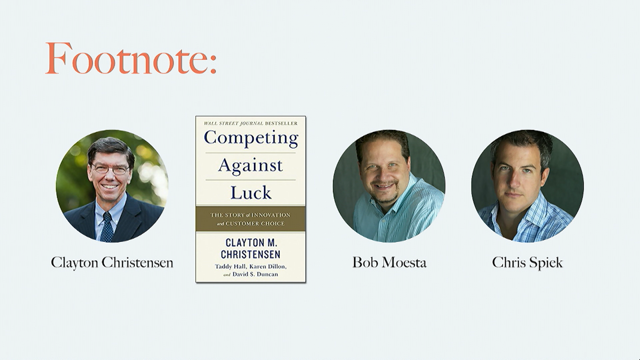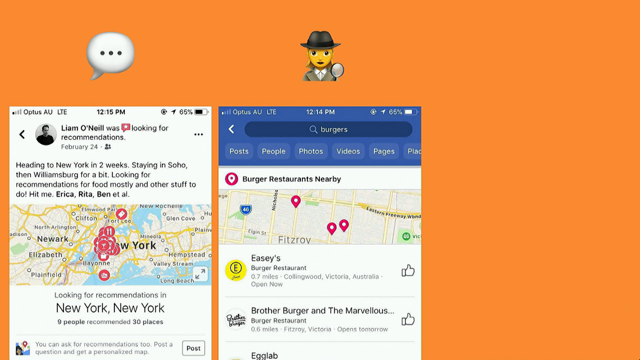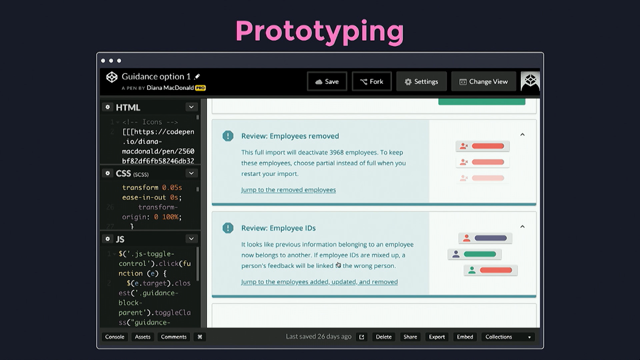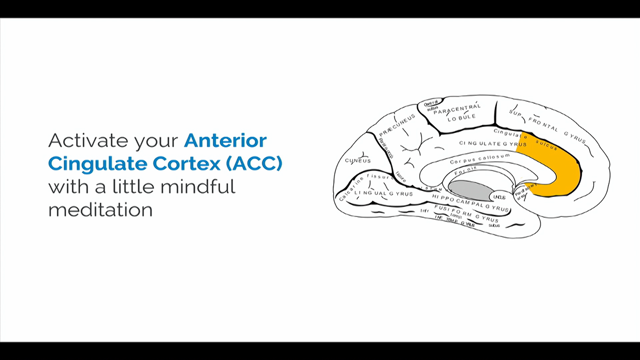Why a poker-playing AI should have designers looking for a new job
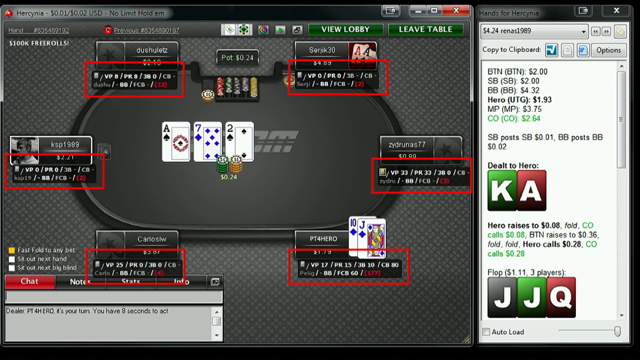
(upbeat music) - Hi everyone, just before I start, I don't like doing caveats before I give a talk but this one kind of requires one.
This is a visual representation of a great talk, so it comes from a TED talk from Nancy Duarte, called The Secret Structure Behind Great Talks, and this is a visual representation of my talk because this is the fourth time I've given it. (laughs) And I know it is not straightforward and I know that you are really really close to coffee, but I just ask that you stick it out with me. So a little bit about me before I start off, I just want you to know three things.
So, one, I'm a UX designer.
I've been doing UX models for about 8 years, a whole variety of things but I do not do visual design, it'll be really really apparent from my slides. The second thing about me, I'm a copywriter, so I started off my career in 2001, but doing some really really badass copywriting, because I was working for the Australian version of The X Games and then went on to work for Globe World Cup Skateboarding, and then went on to some kind of less exciting things and became a content strategist and all that sort of stuff. And the third thing I want you to know about me, is that I used to be a professional poker player. So I think this is one of the photos John was mentioning, so this is me and I got to play on TV once, it was not that great.
I actually misread the hand that knocked me out of the tournament and I celebrated on TV, that went to a 100 million households around the world, and I worked in a variety of roles in the industry as well.
So, I'm gonna tell you a little bit of a story, about how all three of those things collided. So, in January of 2008, I got offered a job to go work for Full Tilt Poker in Dublin.
So I packed up my life and I moved across to Ireland, with all of nine days notice.
But when I got there I found out that things were a little, you know, this is gonna sound a little bit obvious because, you know, I was working in online gambling, things were like a little bit shady, right? (laughs) So I had gotten there, I found out that the company I'd packed up my life and moved halfway across the world for, was a little bit dodgy, and so I stuck it out for six months and quit, which brings me up to July of 2008.
For anyone who is familiar with things, Ireland, July 2008.
So, the quitting of my job coincided almost perfectly with the global financial crisis.
So, I was finding it really really tough to find a job, I also wasn't sure what I wanted to do, because I've been doing copywriting for a really long time.
I was kind of burnt out, and I thought, look, you know, I've been playing poker for a while and the how and why I got into poker is also another story in and of itself.
So, I was actually studying theology in Bible College in Adelaide and I saw late-night poker on TV, and I started playing-- (laughs) It's a lot, I know.
So I started playing at an amateur level and I'd been doing this for a little while and had a little bit of success.
And I just thought, look, I'm just gonna give it a red-hot go, right? So, July 2008, I started as a professional poker player.
And when I say this, right, people, this is what comes to mind.
So, this is a scene from Rounders if you're not familiar with it, it stars Matt Damon, John Malkovich, with a really bad Russian accent.
They think it is about looking at someone over the table and looking into their eyes and reading their soul and finding out their tell.
The way Matt Damon defeats John Malkovich in the penultimate battle is that he finds out his tell is related to Oreos. And I just want to make it clear this is not what I'm talking about.
(audience laughs) At all.
So when I talk about playing professionally my life looked much more like this.
So, I was a tournament player playing twelve tables at a time.
Some of the software that even amateur players use but almost every single professional would use, is called a HUD, a Heads Up Display.
So, Poker Tracker would be one of the most well-known ones but basically it takes your hands as text and puts them into a database and then you are able to set up your database in ways that allow you to collate data on players. So, how aggressive they are, how much they open preflop, et cetera, et cetera. I went and looked up, when I was preparing for my talk, my old databases and I've got something like 500,000, 600,000 hands sitting in there.
So, you know, it's quite systematic.
I guess, I kinda spoiled the story, because the fact that I'm standing here should let you know that my poker career didn't quite work out, right? (laughs) In fact it only really lasted around six months before I totally went bust. And, you know, I was back to not knowing what I wanted to do with my life, and wasn't really sure if I was even going to stay in Ireland.
I had this thought about, you know, there should be a job where you get to fix frustrating things about websites.
So I did a little bit of Googling and it turns out that there is a job where you get to fix frustrating things about websites. So, I had no idea about usability I had no idea about user experience or anything, but I just popped usability, Dublin into Google, found an agency and they had an open role going, and I just thought, do you know what? I'm just going to apply for it, right? And I was like, you know, I used to be a copywriter, at least I can write a good cover letter.
And, it actually, (laughs) and it kind of worked, right? So they gave me an interview for an UX analyst role, on the back of nothing.
Part of the cover letter was saying look, I have no experience whatsoever, and I got through to the final round, which was to do an evaluation of a webform. I kinda threw everything at it and essentially I lost out because it was me and one other person.
The other person had experience.
(laughs) I just remember I had it was just enough in my bank account for a one-way ticket back to Melbourne.
And they called me up, and I was like, "Hi." and they're like "Hi." And it turns out, you know, even though the UX role didn't work out, they had a sales and marketing role, and I've had something like 40 jobs in my career, and one of them was in marketing, working as marketing manager.
And they're like, "Would you come and do "a three month contract with us?" A three month contract into a full-time sales and business dev role, so, I was selling UX, preparing quotes, writing back to tenders, pitchers, all that sort of stuff.
And then, in January of 2011, they asked me if I wanted to switch to the consulting side.
And I was like, "Yes!" So, I made the switch and I had no idea what I was doing, right? Like most small agencies, you just get thrown in the deep end completely. So I was working on a self-service programme project, for a company called Airtricity, who are a gas and electricity provider, and designing a lot of stuff for their mobile site, even though I didn't own a smartphone, and I didn't own a smartphone until 2013.
But, in some ways, it actually was kind of okay, because there were two big things that I noticed when I started having to do wireframes and all this kind of stuff.
And the first was that, types of content, texts, images, video, audio, were very much the same content that I was working with back in 2001.
And also, the ways in which to organise them were actually quite limited as well, so not a lot had changed on that side.
And so, those two things combined I had a thought in my mind, and it's kind of related to this.
So, this is the Nash equilibrium.
It was created by a mathematician called John Nash, and it was actually, what it refers to is it's a solution concept of a non-cooperative game and it's kind of evolves when two or more players, and basically your strategy wouldn't change if you knew that the other person knew your strategy, and if they knew what you were going to do. So, applying this to poker refers to a set of circumstances where even if you could see each other's cards, you wouldn't change your actions, right? And so this was basically being used to solve poker in certain situations, mostly at the end of tournaments.
So, where blinds are really high, you're kind of forced to go all-in, relating to hand ranges and all this sort of stuff. And I had this idea that well, you know, if we could solve design in the same way.
Because to me, poker and UX had quite a lot of similarities.
And so you're probably wondering, What, what are you talking about? So, in poker, we tend to group players by behaviours. So there's a book called The Psychology of Poker and it divides players into playing styles. So, tight versus loose, and aggressive versus passive, so you end up with tight aggressive, loose aggressive, tight aggressive, loose aggressive, I can't remember, but there's four of them. And these are actually very very similar to what we know as personas, right? Poker has these fixed elements, so even though you have players and chips, the combinations of the number of players, or the starting chips that you have.
Even the types of poker, because there's lots of variations of poker out there. And all of those things combined mean that you have a lot of different scenarios going on and lots of different contexts.
And there's often not one right way to do things. So, even when you're playing, you're trying to come up with multiple strategies, and some of these things can actually be really really marginal.
And obviously, you know, when you're working, or playing with a heads up display, you're getting data and you're feeding that back in. So you're kind of refining things over time. And, fundamentally, it is just about human behaviour and actions and reacting to those things.
I really really thought that I was onto something. But, at the time, stuff was not that advanced. So, you don't need to read this slide, but it's from, obviously, xkcd, it's from 2012, it's about the difficulty of various games for computers to solve.
So, easier to solve is at the top, and harder and impossible for computers to solve is at the bottom.
And so, in 2002, poker was still quite a long way off to being solved. And I just thought that the idea I had was not a very good idea, and I'm just going to leave it.
Kind of backing that up, was a report in 2013, called The Future of Employment.
It was done by Oxford, and ranked 702 jobs and concluded that about 47% of employment was at risk of being automated.
But all of the design ones were actually really low, and so when this came out, there was a lot of smug designers on Twitter, and I was like, okay, that thought I had about poker and UX, just not even close, I'm just gonna let it go completely.
And then, a few years go by, you remember the xkcd thing? So, Go was actually below poker and they thought Go would take a long time to get solved. But, in March of 2016, the team from DeepMind defeated Lee Sedol in a five game match, and it was the first time a computer Go programme had beaten a nine dan professional without handicaps. There's a really good documentary on Netflix about this. And then, in January of last year, the Libratus Poker AI beat four players, and it wasn't just four players, it was four high-stakes players.
And there was some things about how they set up the match, it was two sets of two, and the computer mirrored the cards.
So, it was four heads up matches and the computer would have hand A in one, and the player would have hand B and they would flip them for the next pair. They would reset the stacks at the beginning of every hand. And the computer didn't just beat them, it absolutely, totally thrashed them.
And, after this, I went and panicked and started a five-year plan to get out of design so, I'm two weeks into being a product owner, so I actually went and did it one and a half years early! (laughs) There's a lot of hype around AI, so I thought I would just cover it very very very quickly because I'm probably running out of time.
The current landscape and where we are, and I'll run through this very very fast.
So, we have a crop of website builders, so FireDrop is a chat-based AI.
It's probably not going to play.
Wix is ADI, very very similar, so it allows you to input a bunch of answers to questions and generates a website for you.
In the image and video manipulation space, so Adobe Sensei is doing a lot of stuff.
In this they're making you smile more, which is something, I just find it to be completely terrifying. And video is also playing in this space as well, so the images on the left are input images, and the ones on the right are once it's outputted from the generative adversarial I'm going to forget the rest of the acronym, but basically two neural networks playing off each other. So it wasn't given, the images on the right, it wasn't given these two sets of photos, in different climates, but it's able to take landscapes and totally change them.
And then, in terms of the design to HTML space. So PixCode was taking static images to code, I'm sure everyone will be really familiar with Airbnb and sketching interfaces, so actually sketching under a camera and generating live code from that.
And this is inspired from a really long time ago, so in 1996 we were trying to do this as well. Lots and lots of this stuff is at algorithms or design so I've got about five minutes, and I've got lots I wanted to cover.
Just some really really quick thoughts, so, thinking about all of this actually made me go back in time.
So, a lot of these tools don't really feel futuristic, they kind of feel like a butler, right? And it made me think a lot about, if we're imagining the future, why are we imagining the future like this, you know? And I had to go back in time even further to think about it.
This guy called Frederick Taylor wrote a book about scientific management and he had some really weird thoughts about managers and workers, right? So he really believed in the separation of conception and execution, so workers should just do the work, and managers would think about everything else. You probably know it as separation between business and technology, and I would argue that it's actually the way that we're thinking about the role of robots. And so to me, the interesting thing is that if we've got the future, we can imagine the future.
Why are we constraining it with these visions of the past? Why are we constraining it by thinking about it in terms of the way that we work now? So, I had a go at a conclusion, and I was going to talk a little bit about Jakob Nielsen's 100-Year View of User Experience and he's expecting that we will have 100 million designers by the year 2050.
And I want to talk about why this matters, and why the stakes are high because the way I think about this graph is actually more about the shortage.
So, if I was to ask everyone, who's hiring right now I would expect a lot of hands to go up.
I don't know any teams that have been able to maintain a full cohort of designers.
And I think the question to be asked is not about whether it's going to take our jobs or whatever, it's more about what is not going to get designed, right? We have all these companies who are trying to actually lift their hiring numbers, and to decrease the ratio between design and dev, and I don't think my company can compete with the likes of these companies for design resources.
But actually, in thinking about this I realised it was a kind of a bad conclusion. Because, you know, it's almost going back to making us efficient, making everything more streamline.
And I was like, oh no.
I have to give everyone a conclusion.
And even I'm being constrained by my view.
I wasn't able to resolve it, and it turns out the same thing is happening with a lot of people. And I'm a little bit out of time, but I want to say, in imagining the future, and imagining future paradigms, maybe it's not about whether the robots are going to take our jobs at all, right? Genevieve Bell talks about the two main fears of AI. So, the first being that obviously AI will take our jobs, the second being that AI will kill us.
(audience laughs) Her point is that they're actually the same fear. So they're based in a fear of irrelevance.
There's all this stuff I didn't get to cover around diversion inclusion, but there's a quote from Marlin James in Lit Hub where he talks about diversion inclusion panels as being panels that should be concerned with their own irrelevance.
I think there's something there for us because a lot of these things seem to be about making us more efficient, and increasing our output and everything.
But I think what is almost at the root of designers being generally frustrated and angsty is that in some ways our jobs are responses to broken systems.
If we keep trying to do our jobs more efficiently, we never actually get a chance to break the systems, right? In a way, we should almost all be working towards our own irrelevance, or working towards companies that don't need UX designers. And I think it would be a much more interesting way to imagine the future if we thought about it like that. So, thanks.
(clapping) (upbeat music)









